One of the largest reptiles to ever exist in the United Kingdom was the ichthyosaur, a massive fish-like marine reptile that thrived from the Mesozoic period up until around 90 million years ago. The ichthyosaur was first discovered in England, where the first completed skeleton of the creature was unearthed and assembled. Fortunately, England’s largest reptiles today are much smaller than the frighteningly large 60-foot ichthyosaur, but many of them are still quite impressive in size.

Below, we’ll take an in-depth look at five of the largest reptiles that still live in England, where they live, how big they get, and some interesting facts about why they’re so incredible!
1. Leatherback Sea Turtle (Dermochelys coriacea) – Up to 1.8 meters long, 500 kg.
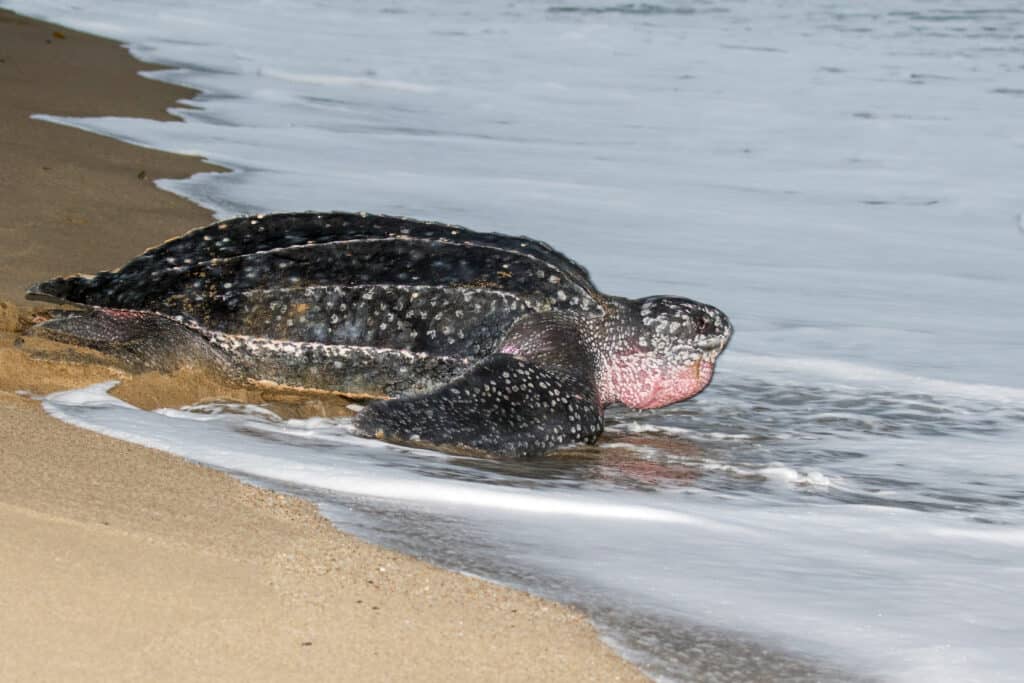
The leatherback sea turtle often forages along the UK’s shores.
©iStock.com/AGAMI stock
Britain is home to very few turtles, but a handful of sea turtles graze and travel along its shorelines. The largest of the bunch is the majestic leatherback sea turtle, a massive reptile that can weigh 500 kilograms (around 1,100 pounds) and measure 1.8 meters (nearly six feet) in length!
As its name suggests, the leatherback’s dark gray shell is not bony but rather leather-like and somewhat soft. It is roughly teardrop-shaped and accented by seven long, thin, raised ridges of bony deposits, also known as osteoderms, running down it lengthwise. Another notable feature of the leatherback’s massive body is its powerful and robust flippers, which can grow to be nearly 3 meters in length.
Today, leatherbacks are quite rare in the United Kingdom. However, they are still occasionally spotted along its western coast, particularly off Wales and Cornwall’s shores during the summer months. They feed heavily on jellyfish and other marine invertebrates like tunicates.
2. Aesculapian Snake (Zamenis longissimus) – Up to 2 meters long
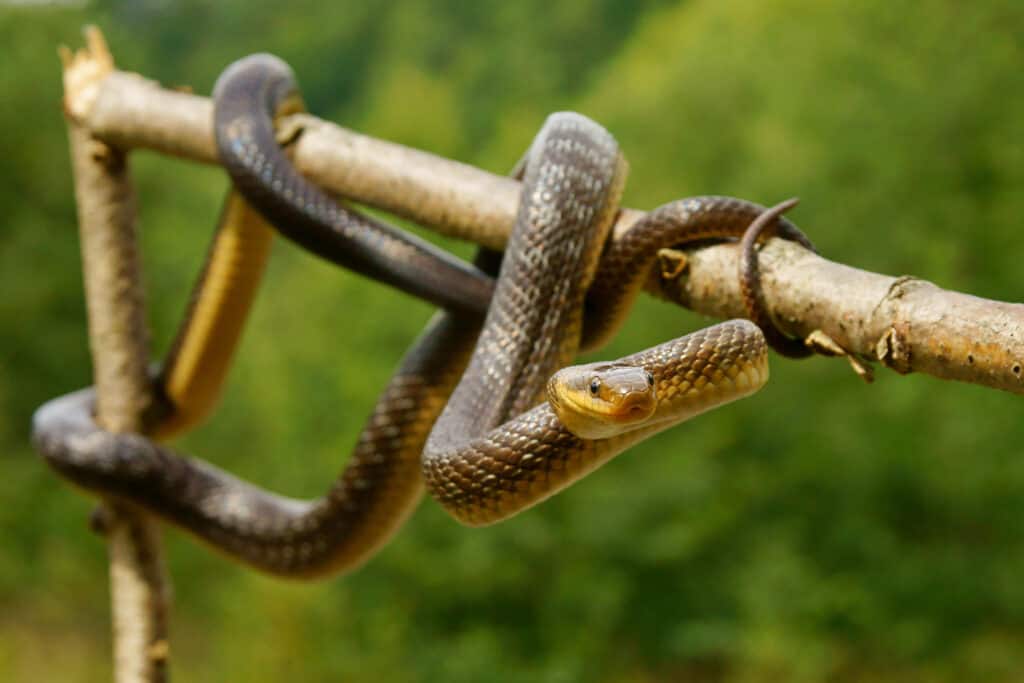
The Aesculapian snake is not only one of the UK’s largest snakes. It’s also one of the largest snakes in Europe.
©iStock.com/SzymonBartosz
One of England’s largest reptiles is an introduced species: the Aesculapian snake. It commonly grows to around two meters long, or around six and a half feet. Originally native to much of southern mainland Europe, this non-venomous serpent was introduced to England in the 1960s. Its long, rather slender body is typically green or yellowish as a juvenile. However, as it ages, its body gradually darkens to a rich, bronze color.
Currently, three populations of Aesculapian snakes exist in the United Kingdom. The oldest and largest of the three colonies exists near the Welsh Mountain Zoo in North Wales. As of 2022, around 70 adult specimens have been documented within this region.
Another population, discovered in 2010, lives outside of the London Zoo along central London’s Regent’s Canal. This group consists of around 40 adult snakes as of 2023.
Finally, the third and most recently described colony lives in Bridgend, Wales. Though it has likely existed for over 20 years, it was only discovered in 2020.
Hardy and adaptable, Aesculapian snakes can reside in a rather wide range of habitats. However, they prefer fairly warm, moderately humid broadleaf forests and forest steppes. They also don’t seem to mind the presence of humans and will take up residence in buildings, sheds, and gardens.
3. Grass Snake (Natrix natrix) – Up to 1 meter long
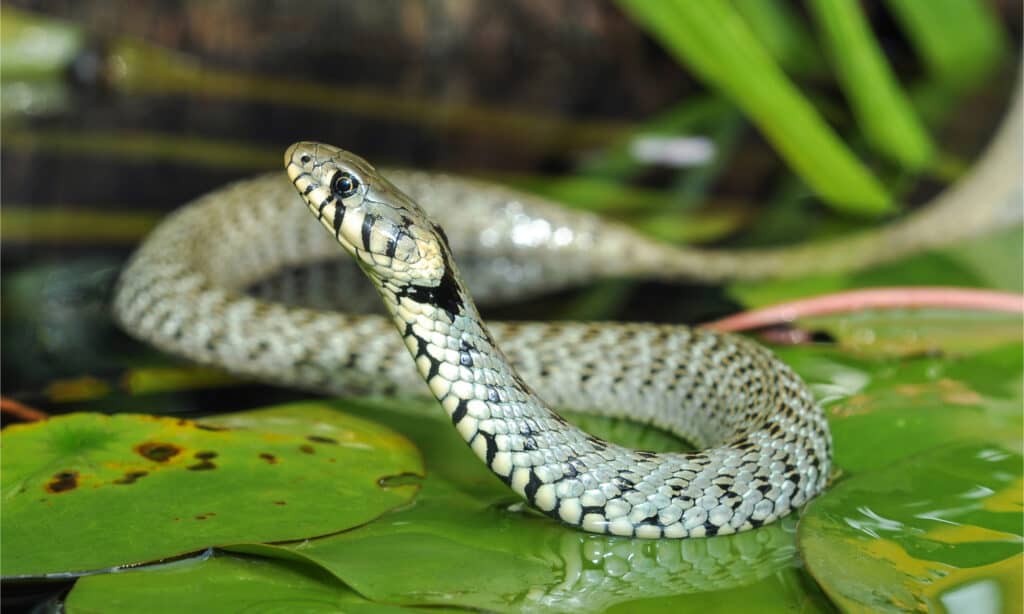
Taxonomically, the grass snake is divided into around 10 unique subspecies.
©Dr.Pixel/Shutterstock.com
England’s second-largest snake–and largest native snake species–is the grass snake, also commonly known as the ringed snake or water snake. It commonly grows to more than one meter (over three feet) in length.
Like the aforementioned Aesculapian snake, the grass snake’s body is also long and fairly slender. The majority of its body is typically either dark brown or greenish-brown in color, and the species can easily be identified by a yellow or whitish collar or ring-like marking at the base of the neck. Another prominent trait is its underside coloration, which is usually white or off-white and broken up by black block-shaped markings.
Grass snakes exist throughout much of mainland Europe as well as the United Kingdom. Around 10 unique subspecies exist. Interestingly, one of Britain’s former grass snake subspecies, Natrix natrix helvetica, was re-classified in 2017 as its unique species: the barred grass snake.
4. Slow Worm (Anguis fragilis) – Up to 57.5 centimeters long
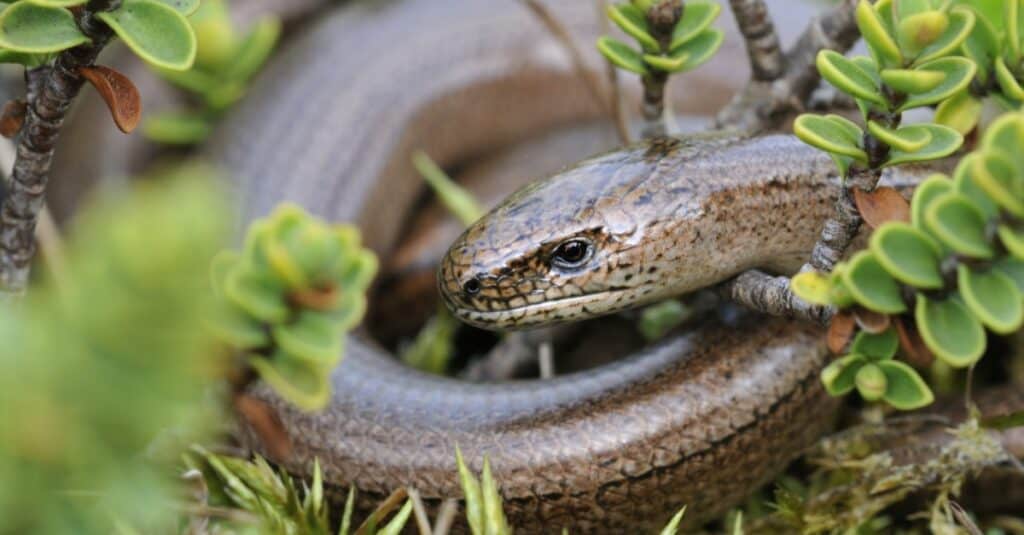
Although the slow worm superficially resembles a snake, it is a
legless lizard
.
©iStock.com/AlasdairJames
Though it appears to more closely resemble a snake at first glance, the bizarre legless slow worm is technically England’s largest lizard and one of its largest reptiles! Its long, smooth body is covered in round or hexagonal scales and can grow to be over half a meter long.
Notably, this unique species is capable of caudal autotomy, meaning it can break off and partially regrow parts of its tail if threatened or pursued by a predator. Its body coloration can vary, from light to dark brown or even gray.
Slow worms are common throughout the United Kingdom as well as much of western Eurasia. They are especially abundant in Wales and southwestern England. As semifossorial species, they spend much of their lives burrowing in soft, moist substrate, such as soil in garden plots. They are also nocturnal and are often spotted basking under warm rocks and logs rather than out in the open in direct sunlight.
5. European Green Lizard (Lacerta viridis) – Up to 40 centimeters total body length
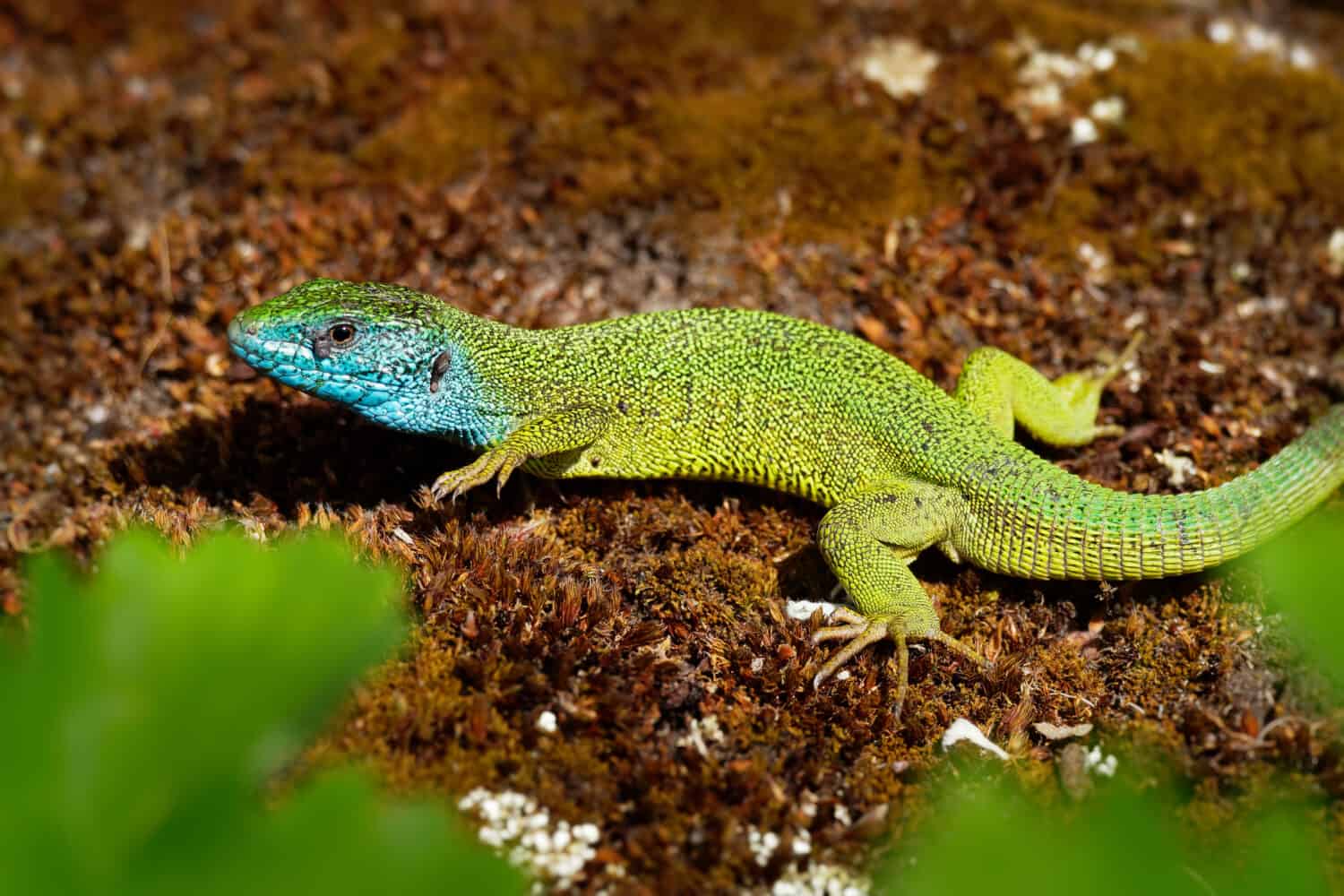
Male European green lizards often have bright blue throats. Females of the species can also have a bluish tinge, although their coloration is much less vibrant.
©Martin Pelanek/Shutterstock.com
England’s second-largest lizard is the European green lizard, named for its rich green coloration and chiefly European geographic range. Including its tail, it can reach more than 40 centimeters–or close to half a meter–in length. Its snout-to-vent length is around 15 centimeters long. Like the slow worm above, it is also capable of autotomy, shedding its long, flexible tail if needed and re-growing it later.
European green lizards have a wide geographic range. The species is native to southeastern Europe. However, it has been introduced to parts of Western Europe, as well as the United States. It has even been found among the Channel Islands, specifically Jersey off of England’s southern coast.
As a slightly sexually dimorphic species, male and female European green lizards differ somewhat in appearance and size. Most notably, male specimens have a rich, blue patch of color along their throats. Although females can also have this blue marking, the males are much more vibrant. Additionally, males are larger and have larger heads overall.
Summary of 5 Largest Reptiles Still Living in England
| Rank | Species | Size |
|---|---|---|
| 1 | Leatherback Sea Turtle (Dermochelys coriacea) | 1.8 meters, 500 kilograms |
| 2 | Aesculapian Snake (Zamenis longissimus) | 2 meters |
| 3 | Grass Snake (Natrix natrix) | 1 meter |
| 4 | Slow Worm (Anguis fragilis) | 57.5 centimeters |
| 5 | European Green Lizard (Lacerta viridis) | 40 centimeters |
The photo featured at the top of this post is © iStock.com/SzymonBartosz
Thank you for reading! Have some feedback for us? Contact the AZ Animals editorial team.






